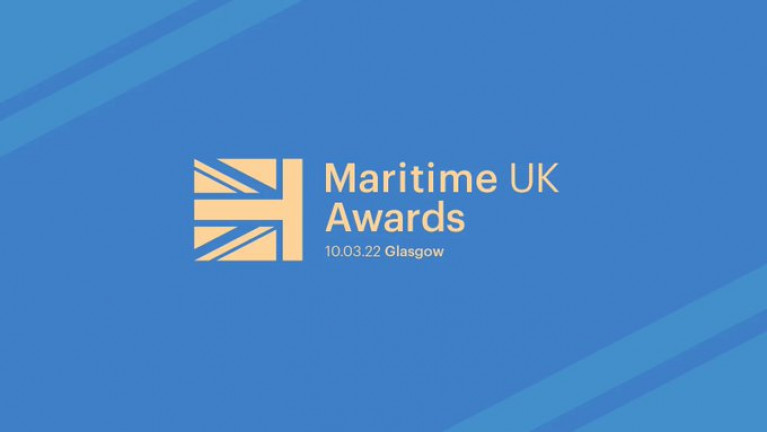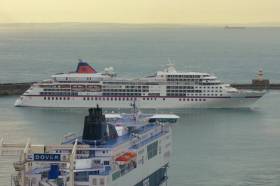Displaying items by tag: Maritime UK Awards
Prestigious Industry Award for Peel Ports Group Approach to UK Government’s Maritime 2050 Strategy
Peel Ports Group, one of the UK’s largest port operators, has won the Maritime UK award for seizing opportunities presented within the UK Government’s strategy for the sector - including its commitment to become a net zero port operator by 2040.
The leading port group emerged successful in the 2050 category after demonstrating its impressive focus on the core objectives of the Maritime strategy, which was created in partnership between the Government and industry.
The award, which was sponsored by the Department for Transport, acknowledges the steps the port operator has taken to deliver on the seven key strategic themes of the initiative, which are: Environment, Infrastructure, Technology, Security&Resilience, People, UK Competitive Advantage and Trade.
The win comes off the back of what was another game-changing year for Peel Ports, with the group demonstrating continued resilience in the face of the ongoing challenges posed by the pandemic and Brexit.
In 2021, the group announced its commitment to becoming net zero by 2040, ten years ahead of the Government’s national targets. It is the first major port group to make such an ambitious pledge.
In addition, last year, the port operator enabled the launch of several new services and trade opportunities, such as a freight-only ferry service connecting the Port of Sheerness and Calais with operator DFDS and the expansion of new multi-modal rail connections and crane capacity at the Port of Liverpool.
Major infrastructure investments over the last decade, to the tune of £1.2 billion, include the concept and launch of Liverpool2, a £400m deep water container terminal and the £100m development of a custom-built biomass import facility. It also includes the ongoing regeneration of Hunterston PARC, showcased by the government as one of the UK’s most exciting inward investment opportunities for the blue and green economy.
Speaking of the award, Mark Whitworth, CEO at Peel Ports said: “Being recognised for our efforts in the 2050 category is a fantastic, progressive achievement for our teams.
“We are proud to have worked tirelessly to support the key objectives of Maritime 2050, as well as facilitating continuous economic growth at a national and regional level.
“The recognition from our peers supports the resilience we have shown in the face of challenges posed by the pandemic, global port congestion and Brexit.
“Our teams continue to rise to every challenge and our success over the last 12 months has further positioned our ambitions for sustainable growth and the positive economic impact this has on the regions we operate within.”
The Maritime UK Awards ceremony took place on 10 March at the Glasgow Science Centre, with the awards presented by award-winning broadcaster Jennifer Reoch.
The event celebrates the work of the maritime sector, which is one of the UK’s biggest industries, adding £46.1bn to the economy every year and supporting 1.1 million jobs.
The Maritime UK Awards are open to all organisations from across the breadth of the maritime sector, including shipping, ports, services, engineering and leisure, and the award categories themselves are designed to reflect the themes of the Maritime 2050 strategy.
It is the third award Peel Ports Group has won in the last 12 months after being recognised as Greenfleet’s private sector commercial fleet of the year for its conversion to electric vehicles, as well as winning UK Ports Directory’s port operator of the year award.
Get Ready for Glasgow '2022' As Maritime UK Launches Awards Programme
Maritime UK launched today its national awards programme for 2022, celebrating the shipping sector worth over £46.1bn to the UK economy and supporting over 1 million jobs.
⦁ Maritime UK Awards 2022 to be held at Glasgow Science Centre
⦁ Awards to again include government’s ‘Clean Maritime Awards’
⦁ Panel of expert judges from across industry and government
⦁ Online portal opens for entries
This will be the first time since the event took place in September 2019 and Maritime UK Awards are run by the industry for the benefit of the industry.
From a judging panel of internationally recognised maritime leaders to an awards evening at the Glasgow Science Centre, the Maritime UK Awards are a unique and impactful way to showcase individual business, and collectively, to celebrate a thriving sector, worth £46.1bn to the UK economy.
The portal for submissions has opened today.
The Maritime UK Awards are open to organisations from across the breadth of the maritime sector and its component shipping, ports, services, engineering, and leisure marine industries.
With the UK government having launched its first long-term strategy for the sector, Maritime 2050, the award categories mirror its themes. In June 2021, Maritime UK published a stocktake of progress in implementing the strategy, with demonstrable progress being made across the board. The 2022 awards will enable many of the projects being delivered in response to Maritime 2050 to be brought to national prominence.
The third Maritime UK Awards are being held at the Glasgow Science Centre, on the banks of the River Clyde, synonymous with the country's shipbuilding industry. Glasgow has been chosen as the host for the 2022 awards to build upon the sector's activity at COP26. For the second time, the Department for Transport's Clean Maritime Awards will be included in the programme.
The 2020 awards were held in Plymouth, where the winners included: STEM Returners, Actisense, Tanki, Port of Cromarty Firth, Babcock International, Princess Yachts, Solent LEP, Artemis Technologies, Port of Tyne, VIRSEC and Tapiit Live.
Maritime UK today announces the first two category sponsors as Malin Group (Innovation Award) and Nautilus International (Bevis Minter Award).
Sarah Kenny, Maritime UK Chair said: “We are hugely excited that Glasgow will host the Maritime UK Awards. We have been determined that the awards will shine a spotlight on different parts of our maritime nation, and in Glasgow and Scotland as a whole, we have an incredibly compelling maritime proposition as the UK’s second-largest cluster. It offers Europe’s largest ship management cluster, world class naval ship design, build and support, globally recognised support to offshore energy operations, world-class nautical training and maritime universities and academics.
“2021 has been a year of significant activity for the maritime sector, whether on Freeports, the National Shipbuilding Strategy, Clean Maritime Demonstration Competition, London International Shipping Week, COP26 or at October's Budget and Spending Review, where the Chancellor announced reforms to Tonnage Tax. The 2022 awards will therefore be a fantastic opportunity to showcase and celebrate the growing number of world-leading projects helping to ensure the UK's position as the most innovative, competitive, and sustainable maritime centre by the middle of this century."
Inaugural Maritime UK Awards to Be Held During Southampton Boat Show
Recently announced were the finalists for the inaugural Maritime UK Awards which will be held next month during the Southampton Boat Show.
According to the British Ports Association (BPA) the winners will be announced in front of 400 of the industry’s finest at a ceremony in Southampton on Thursday 19 September.
Included in the list of finalists are a number of UK ports among them Afloat adds the Port of Dover as previously reported.
The awards focus on a wide range of areas including business growth, innovation, sustainability, diversity, education and the future.
The finalists from the ports sector are as follows:
• Port of Dover for the International Trade Award - awarded to businesses that are actively involved in international trade and have significantly increased their import/export activity or attracted Foreign Direct Investment
• Port of Cromarty Firth, Port of Dover and Associated British Ports for the Sustainability Award - awarded to organisations that demonstrate exceptional true commitment to sustainability
• Port of Tyne for the 2050 Award - awarded to businesses that are taking steps to capitalise upon the opportunities presented within the Government’s Maritime 2050 strategy launched earlier this year
• Port of Cromarty Firth for the Coastal Powerhouse Award - awarded to those organisations that have proven themselves as a driver or catalyst for growth within a coastal community
British Ports Association members Royal Haskoning and Hill Dickinson are also both finalists for the Employer of the Year Award.
Commenting on yesterday’s announcement, Sara Walsh, Corporate Services Manager at the British Ports Association said: “We are delighted to see a number of UK ports being shortlisted in the first ever Maritime UK Awards. The ports industry plays a vital role in our economy, facilitating over 95% off the UK’s international trade. As demonstrated by the number of ports who are finalists for the Awards, the sector provides important hubs of regional and nationally significant economic activity and employment, often in areas of deprivation.
To see all three finalists of the Sustainability Award being ports (Port of Cromarty Firth, Port of Dover and Associated British Ports) is a testament to the UK ports sector and what we have achieved to deliver a true commitment to improve sustainability. We are continuing to advise on how Government can work with industry to deliver further improvements and we are committed to supporting sustainability and decarbonisation, having produced our first Sustainability Charter last year.






























































